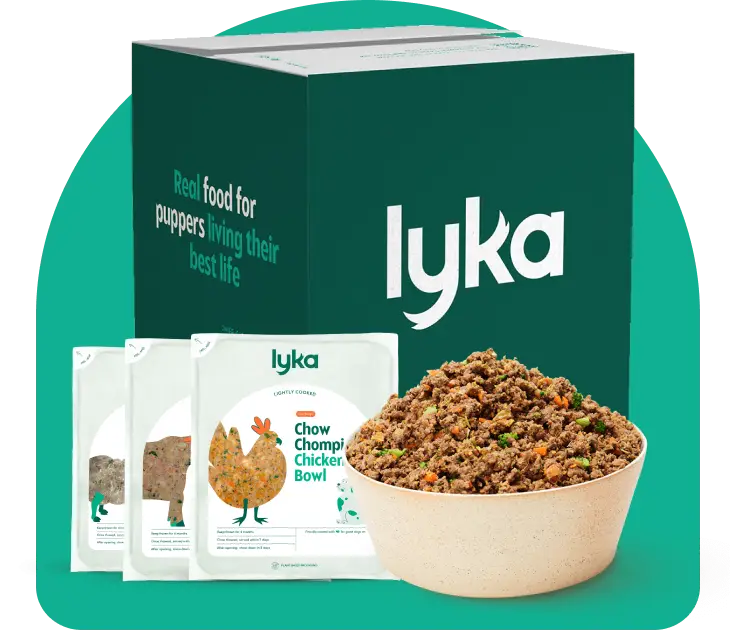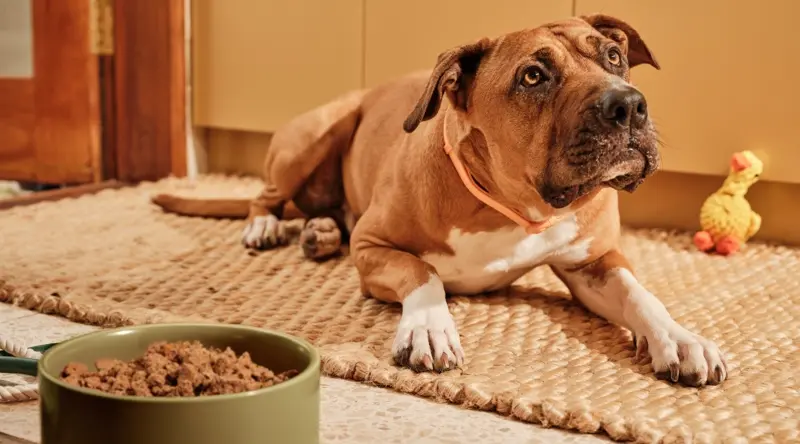Does your pup scoot along the ground, leaving an unpleasant smell behind? They may be experiencing anal gland issues: Lyka’s veterinary experts are here to explain.
Identifying what's triggering your pup’s rear-end problems is the first step in prevention, and a diet that lacks the right macro and micronutrients and the right amount of fibre is often the culprit. Real, nutritionally balanced food can support your dog's overall health and put an end to anal gland problems.
Key takeaways
Your dog's anal glands are located on either side of their anus. They are two tiny, fluid-filled sacs that produce an oily substance with a pungent, fishy smell.
Watch for scooting, licking, or swelling, and address symptoms promptly to prevent complications.
If your dog’s stools are often very soft, they might not put enough pressure on the sacs to squeeze the fluid contents out. This fluid build-up can lead to blockages.
Swollen anal gland abscesses are very painful and can burst without prompt treatment. Never treat anal gland abscesses at home, they require professional veterinary care to prevent pain and damage.
A high-fibre, high-moisture diet with ingredients like cooked pumpkin and quinoa helps promote firm stools, aiding natural gland emptying and reducing anal swelling and other related issues.
What are anal glands in dogs?
Your dog’s anal glands are located on either side of their anus. They are two tiny, fluid-filled sacs that produce an oily substance with a pungent, fishy smell.
The purpose of anal glands is to communicate vital information including sex, hormones, and health. The smell of anal gland secretions is unique to your dog: it’s the reason dogs greet each other with a quick sniff of their behind.
When your pet defecates, their faeces apply pressure against the anal glands when passing through — expressing the fluid from the glands. For most pups, passing a healthy, firm poo is enough to empty their anal glands. Anal gland issues occur when the glands fail to empty on their own.
7 symptoms of blocked anal glands in dogs
If your dog’s stools are often very soft, defecation might not put enough pressure on the sacs to squeeze the fluid contents out. The build-up of this fluid can lead to anal gland disease (or anal sac disease), as the area becomes blocked with thicker, sometimes gritty secretions.
Early treatment is key in addressing anal disease and could help avoid invasive procedures or more serious symptoms. Speak to your veterinarian if you notice:
Excessive licking or biting their anus
Scooting their rear end along the floor
Difficulty or discomfort when toileting
A stinky discharge
Blood or pus in their stools
Signs of pain like yelping or whimpering
A red or swollen area on one or both sides of their anus (a sign of an abscess)
Soft stools can lead to anal gland problems — but they’re also a sign of parasites. It’s worth making sure your dog is up to date on their regular parasite medication.
Should anal glands be manually expressed?
If your dog is having trouble emptying their anal glands, your veterinarian may need to express them by hand. This is a relatively quick procedure: your veterinarian will apply internal pressure to the glands just inside the anus, to squeeze out the contents.
Manual anal gland expression shouldn’t be a regular occurrence — repeated expression can affect muscle tone of the sacs and anus, making natural excretion more difficult.
If your dog is experiencing chronic anal gland issues, speak to your veterinarian about whether an underlying health issue is at play.
Can I express my dog’s anal glands at home?
We highly recommend seeking veterinary assistance, rather than trying to do it yourself or requesting that your groomer do it.
Veterinarians can apply the right amount of pressure to the right place — ruptures, inflammation, and serious health issues can result from too much pressure on swollen and impacted glands.
Understanding common causes of anal gland problems
There are multiple causes for anal gland issues, and more than one factor can contribute to symptoms.
Inflammation
Inflammation can block the duct, preventing the release of fluid — over time, this can lead to a bacteria build-up, resulting in further inflammation, infection or abscesses. An abscess may rupture and leave an open hole in the rectum that’s likely to require surgery.
Breed genetics
Any breed can experience anal gland problems, but it tends to be more prevalent in smaller breeds like chihuahuas, miniature and toy poodles, cocker spaniels, and beagles. Some dogs are also born with abnormal anal gland anatomy, while others develop these narrow or kinked ducts due to scarring and inflammation from recurring anal gland issues.
Inconsistent stools
Dogs with diarrhoea or constipation will often also have impacted anal glands. This is because their faeces are too soft or not passing, which can lead to the glands not being expressed properly or enough.
Obesity
Obesity can affect your dog’s movement, agility, and ability to get adequate exercise — this can impact their bowel movements. Overweight dogs may not be able to lick their anus or scoot, which helps to promote secretion of the glands.
Read more: Is my dog the right weight?
Can food cause anal gland issues in dogs?
Highly processed diets, and foods low in fibre, lead to softer stools: which means there’s not enough pressure to empty the glands naturally. A balanced diet, rich in soluble and insoluble fibre, helps produce firmer stools while promoting healthy anal gland function.
Some dogs with food or environmental allergies are more prone to anal gland issues: allergies trigger an immune response in your dog, which can lead to inflammation in the body. For dogs with known food allergies, consider a fresh hypoallergenic diet.
Anal gland complications: what to expect
Anal gland disease can cause inflammation, impaction, and abscessation of the sacs:
If a gland becomes inflamed, the swelling can tighten the ducts that connect to the rectum, making it more difficult to release flued. When this happens, the fluid thickens and becomes impacted.
An impacted gland is more likely to develop an infection as the bacteria builds up with nowhere to escape. This can lead to a painful abscess. If the abscess isn’t treated, it can rupture through the skin next to the anus.
Anal glands are not vital for life and can be removed in more serious circumstances. This type of surgery is known as an anal sacculectomy — this course of action should only be considered as a last resort, as it can lead to complications if performed incorrectly.
Speak to your veterinarian about enlisting the help of a specialist surgeon if needed.
What’s the best dog food for anal gland issues?
If your dog is experiencing anal gland issues or their stools are loose and soft, leading you to take a preventative approach, diet and nutrition can play a central role in recovering their health and wellbeing.
Real food that goes above and beyond nutritional standards
A highly digestible diet is the best food for anal gland health. More nutrients are absorbed by their digestive system, leaving relatively little waste and creating firm stools — the ideal consistency to put pressure on their anal glands.
Lyka’s vet-formulated meals are made from real ingredients. Each tailored serving contains the right amount of macro and micronutrients for your pup’s daily needs, leading to smaller, firmer, healthier poos. After all, good poos are a sign of good health!
Increase dietary fibre
Increasing the fibre content of their diet can be an excellent way to promote regular bowel movements and make their poo firmer. Introducing a variety of real, high-fibre ingredients into your pup's food can help express their anal glands naturally:
Butternut squash is a particularly good fibrous vegetable to add to your dog’s bowl. Start by adding a small amount of cooked pumpkin to their meal — this will help you to avoid adding too much fibre, allowing your dog’s system to get used to digesting it. Although you can feed your pup raw pumpkin, it can be very difficult to digest, so we recommend you cook it first.
If you are using canned pumpkin, make sure that it does not have any additional ingredients like sugar, salt or spices. Always check that it doesn’t contain any xylitol as this is highly toxic to dogs.
Lyka’s Chicken, Turkey, and Kangaroo meals all include a healthy amount of butternut pumpkin to keep your dog’s stools firm and healthy.Quinoa is a great source of slowly fermentable fibre, which is good for the gut microbiome.
Sweet potato help support your dog’s digestive system by promoting regular bowel movements and maintaining a healthy gut microbiome. The prebiotics in sweet potatoes also encourage the growth of good bacteria in the gut, improving digestion.
Carrots are chock full of insoluble fibres that play a vital role in removing toxins from the colon, keeping your pupper’s digestive health in tip-top shape.
Broccoli contains prebiotic dietary fibre, feeding the good bacteria in your dog’s gut to promote a healthy microbiome and smooth digestion.
Beetroot powder delivers antioxidants and fibre, supporting heart health and aiding in digestion.
Cauliflower provides a fibre-rich snack that promotes healthy digestion and overall well-being.
Anti-inflammatory ingredients
A diet that’s rich in powerful anti-inflammatory ingredients like omega essential fatty acids (EFAs), ginger, spirulina and turmeric can alleviate swelling and prevent inflamed anal glands.
In addition to these potent bioavailable ingredients, our meals only contain grass-fed, free-range or barn-raised proteins, which are less prone to cause inflammation than grain-fed proteins.
Ensuring your pup is hydrated for optimal anal gland health
Dehydration affects the efficiency of a dog’s digestive system and can often lead to constipation. If your pup suffers from anal gland problems, straining to pass a hard poo can make matters worse.
Give your dog access to plenty of fresh water to keep them hydrated or encourage them to drink more by using a water fountain.
Lyka meals are made from fresh food and are gently cooked to maintain nutritional value and high moisture content for healthy, hydrated pups.
Choose real food for healthy digestion and a balanced gut
Your pup’s gastrointestinal (GI) tract goes from their mouth to their stomach and intestines and ends at their colon and anus. Their anal glands are part of their GI tract and digestive system. In addition to processing the nutrients in their food, more and more research points to the central role of your dog’s gut in sustaining their overall health and wellbeing.
The microbiome is the powerhouse of your dog’s digestive system. A strong microbiome contains trillions of diverse microorganisms that regulate hormones, neurotransmitters, metabolism and the immune system.
Read more: Why real food could be your dog’s gut health hero
Lyka’s gently cooked dog food is formulated by a team of board-certified veterinary nutritionists. We only use human-grade, fresh ingredients in our dog food, and each meal contains natural antioxidants and anti-inflammatory ingredients — ideal for dogs with digestive and GI issues.
Don’t just take our word for it, read about Melissa’s experience with her dachshund, Billy:
“Billy was eating dry food for years and needed his anal glands expressed every two weeks. We changed to Lyka and he has been one super happy pup. He doesn’t scoot along the ground anymore and he hasn’t needed his anal glands expressed since we started Lyka just over a year ago. We couldn’t be happier with Lyka!”
— Melissa, Billy’s fur parent
The best way to boost your pup’s gut microbiome is by giving them a nutritionally complete diet chock-full of bioavailable nutrients — it’s as simple as that.
)
)
)

)
)
)
)
)
